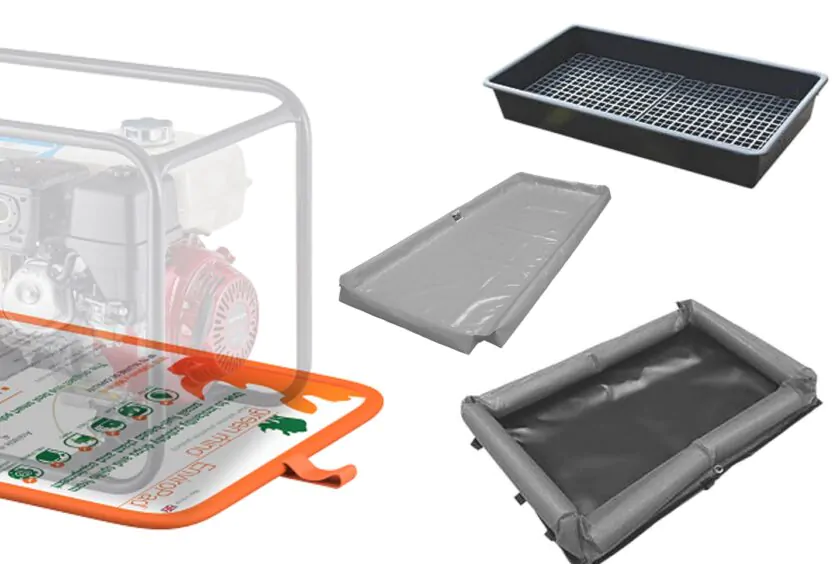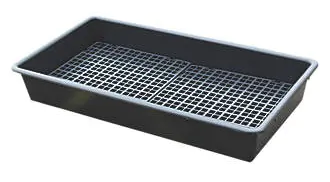Which Spill Mats and Pads are Best for Absorbing Oil?

If you are responsible for pollution prevention, you need to know which spill mats and pads are best for absorbing oil. Spill pads, spill mats, nappies and spill trays are all types of product designed to capture oil leaks and fuel spills from motor-driven tools, machinery and plant. Spills commonly occur while refuelling equipment or topping up oil. In addition, oil can leak out from older or poorly-maintained equipment.
Under pollution prevention legislation, failure to implement effective spill control measures can lead to site closure, prosecution and fines, not to mention reputational loss from negative headlines. (See Know the Law: Spill Prevention & Dewatering.)
When it comes to choosing spill containment mats, it is important to select the right product type for the job. Ineffective or poorly-designed products won’t prevent pollution and won’t protect you from fines. Using high quality oil drip mats will ensure you protect the environment, minimise your risks and ensure a cleaner workplace for your employees. The good news is that the best products on the market are not necessarily the most expensive.
So which are the best spill containment products for indoor and outdoor use?
Products designed to capture leaks and spills can be split into three categories:
- Spill trays
- Absorbent spill mats, pads and nappies
- Smart polymer spill pads
Spill Trays
Spill trays are simple steel or plastic bunds used for collecting and containing leaked or spilt contaminants. Low-cost and highly reusable, they are very popular for indoor use. Trays are best for collecting free-flowing liquid, for example when draining an oil sump. For oil drips, a tray might be overkill and an absorbent oil spill pad could be considered.

Spill trays should not be used outdoors as rainfall may cause them to overflow – releasing pollutants into the environment.
| Advantages | Disadvantages |
|---|---|
| Low-cost | Can fill with rain and overflow |
| Robust & Reusable | Water pooled inside must be disposed of in a compliant manner |
| Wide range of sizes | Trays can corrode and degrade |
| Cumbersome to transport and store | |
| Solid sidewalls mean that vehicles can’t be driven onto them |
Absorbent Spill Pads, Mats and Nappies
Polyproplene-based absorbents are the active material in the majority of spill containment products and spill kits on the market today.
Although commonly used outdoors, polypropylene absorbents do not retain pollutants permanently. Polypropylene is a sponge-like material; liquid can go in but it can also come out again.
This is most evident when it rains. If polypropylene gets saturated, the absorbed pollutants can float out on top of the excess water. A rainbow sheen around these products after rainfall is a tell-tale sign.
To get around this, some polypropylene spill containment products have sidewalls but, oddly, these usually contain the same absorbent material as the base – so the contaminants can still leak out as the product fills with water.

Any contaminated water contained inside must be disposed of in a hazardous waste bin. This presents two problems: firstly, the volume of contaminated water generated in wet weather would significantly increase your waste disposal costs. Secondly, products with sidewalls are impractical to move when full without spilling water over the sides. In reality, operatives often leave them to overflow or tip the contaminated water onto the ground.
Contaminants are also likely to drain out if these products are stored or carried in an upright position after use. Jet washing, too, will flush contaminants out.
Absorbent-based pads, mats and nappies can be used until their quoted oil retention capacity is reached, although for reasons explained above this is a somewhat redundant concept.
| Advantages | Disadvantages |
|---|---|
| Reusable | Prone to leaking when saturated |
| Wide range of sizes | Leak when carried or stored vertically |
| Effective indoors for drips and small spills | Risk of pollution and fines remains |
| Can be used outdoors in dry weather | Added waste disposal costs |
| May encourage non-compliant behaviour |
Smart Polymer Spill Mats
Smart polymer spill mats use an innovative process to solidify oil, fuel and other hydrocarbons inside the pad – neutralising the pollutants.

Green Rhino’s EnviroPad® is the market-leading smart polymer spill mat and the only one designed for outdoor use. Its proprietary smart polymer reacts with hydrocarbons forming a solid and insoluble rubber-like substance.
The solidified pollutants are trapped inside the mat and physically cannot leak out. Rainwater isn’t contaminated by solidified pollutants, so excess water can be allowed to drain out before storage or disposal.
EnviroPad® is available in a range of sizes including models large and robust enough for drive-on, drive-off refueling stations.
A unique feature of the EnviroPad spill mat is that it has operating and disposal instructions printed on it, ensuring that operatives know how to use the pad correctly and can easily determine when it needs replacing.
Smart polymer spill mats can be reused until their oil retention capacity has been reached.
See EnviroPad on the Considerate Constructors Best Practice Hub.
| Advantages | Disadvantages |
|---|---|
| Zero leakage in any conditions | None |
| Eliminate risk of pollution and fines | |
| Easy to transport and store | |
| Rugged and reusable | |
| No waste water |
Verdict
So, which spill mats and pads for absorbing oil? For indoor use (e.g. vehicle depots and maintenance workshops), where rainfall doesn’t create a secondary spill risk, a metal or plastic spill tray is a cheap and effective solution – especially for collecting free-flowing liquid. If drips and small spills are the risk, a spill pad may be considered.
For outside use, spill trays and absorbent based spill pads, mats and nappies will fill with rainwater which may overflow or be tipped out onto the ground by site workers. This isn’t preventing pollution, it’s just delaying it.
The best spill containment option for outdoor use is the EnviroPad® smart polymer spill mat. It doesn’t leak, doesn’t create waste water for disposal and – surprisingly – costs less than the market-leading absorbent-based products. See for yourself by booking an onsite demonstration using the orange button at the top and bottom of the page.
| Spill Tray | Absorbent-based | Smart Polymer | |
|---|---|---|---|
| Spill control | Contain | Absorb | Solidify |
| Where to use | Indoors only | Indoors / Outside in dry weather | Indoors / Outside |
| Risk when rains | Overflows | Leaks / Overflows | None |
| Risk when moved | Spills | Leaks / Spills | None |
| Can be drained | No | No | Yes |
| Reusable | Yes | Yes | Yes |
| Waste disposal | Contents of tray must be disposed of as hazardous waste | Spent product and any water pooled inside must be disposed of as hazardous waste | Spent product must be disposed of as hazardous waste |
| Price range | £–££ | ££–£££ | ££–£££ |
| Potential lifetime cost | ££-£££ | ££–£££ | £-££ |
